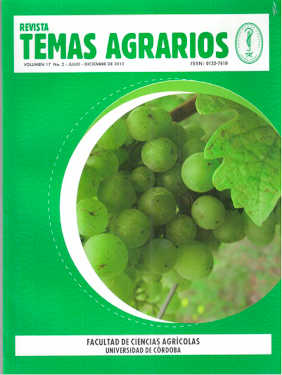Evaluation of the viscosity and the color of common mango pulp (Mangifera indica L.) enzymatically treated
Evaluación de viscosidad y color en la pulpa de mango común (Mangifera indica L) tratada enzimáticamente
How to Cite
Quintero, V., Duque, A., & Giraldo, G. (2012). Evaluation of the viscosity and the color of common mango pulp (Mangifera indica L.) enzymatically treated. Sour Topics, 17(2), 66-76. https://doi.org/10.21897/rta.v17i2.703
Dimensions
license

This work is licensed under a Creative Commons Attribution-NonCommercial 4.0 International License.
Show authors biography
Article visits 3311 | PDF visits
Downloads
Download data is not yet available.
- Alkorta, I., Garbisu, C., Llama, M. J. y Serra, J. 1998. Industrial applications of pectic enzymes: a review. Process Biochemistry 33(1):21-28.
- Bhattacharya, S. and Rastogi, N. K. 1998. Rheological properties of enzymetreated mango pulp. Journal of Food Engineering 36(3):249-262.
- Bon, J., Vaquiro, H., Benedito, J. and TelisRomero, J. 2010. Thermophysical properties of mango pulp (Mangifera indica L. cv. Tommy Atkins). Journal of Food Engineering 97(4):563-568.
- Ceci, L. y Lozano, J. 1998. Determination of enzymatic activities of commercial pectinases for the clarification of apple juice. Food Chemistry 61(1-2):237-241.
- Demir, N., Acar, J., Sarioglu, K. and Mutlu, M. 2001. The use of commercial pectinase in fruit juice industry. Part 3: Immobilized pectinase for mash treatment. Journal of Food Engineering 47(4):275-280.
- Missang, C., Massiot, P., Baron, A. and Drilleau, J.F. 1993. Effect of oxidative browning of apple pulp on the chemical and enzymatic extraction of cell wall polysaccharides. Carbohydrate Polymers 20(2):131-138.
- Grassin, C. and Fauquembergue, P. 1996. Application of pectinases in beverages, In: J Visser and A.G.J. Voragen, Editor(s), Progress in Biotechnology, Elsevier, Pectins and Pectinases. Proceedings of an International Symposium 14:453-462.
- Iagher, F., Reicher, F. and Ganter, J.L. 2002. Structural and rheological properties of polysaccharides from mango (Mangifera indica L.) pulp. International Journal of Biological Macromolecules 31(1-3):9-17.
- Karunasawat, K. and Anprung, P. 2010. Effec of Depolymerized Mango Pulp as a Stabilizer in, Oil-in-Water Emulsion Containing Sodium Caseinate. Food and Bioproducts Processing, In Press, 88, (2– 3):202-208.
- Kashyap, D. R., Vohra, P. K., Chopra, S. and Rewari. R. 2001. Applications of pectinases in the commercial sector: a review. Bioresource Technology 77(3):215-227.
- Liew, Abdullah, A.G., Sulaiman, N.M., Aroua, M.K. y Megat, M.J. 2007. Response surface optimization of conditions for clarification of carambola fruit juice using a commercial enzyme. Journal of Food Engineering 81(1):65-71.
- Pelegrine, D.H., Silva, F. C. and Gasparetto, C. A. 2002. Rheological Behavior of Pineapple and Mango Pulps. Lebensmittel-Wissenschaft undTechnologie 35(8):645-648.
- Pretel, M.T., Lozano, P., Riquelme, F. and Romojaro, F. 1997. Pectic enzymes in fresh fruit processing: optimization of enzymic peeling of oranges. Process Biochemistry 32(1)43-49.
- Quaglia G B, Gennaro L, (2003). ENZYMES I Uses in Food Processing, In: Benjamin Caballero, Editor(s)-in-Chief, Encyclopedia of Food Sciences and Nutrition, Academic Press, Oxford, 2125-2139.
- Rai, P., Majumdar, G.C., and Dasgupta, S. De S. 2004. Optimizing pectinase usage in pretreatment of mosambi juice for clarification by response surface methodology. Journal of Food Engineering 64(3):397-403.
- Sarioglu, K., Demir, N., Acar, J. and Mutlu, M. 2001. The use of commercial pectinase in the fruit juice industry, part 2: Determination of the kinetic behaviour of immobilized commercial pectinase. Journal of Food Engineering 47(4):271-274.
- Sreenath, H.K., Sudarshana, Krishna, K.R. and Santhanam, K. 1995. Enzymatic liquefaction of some varieties of mango pulp. LWT - Food Science and Technology 28(2):196-200.
- Valente, M. y Ferrandis, J.I. 2003. Evaluation of textural properties of mango tissue by a near-field acoustic method. Postharvest Biology and Technology 29(2):219-228.




















